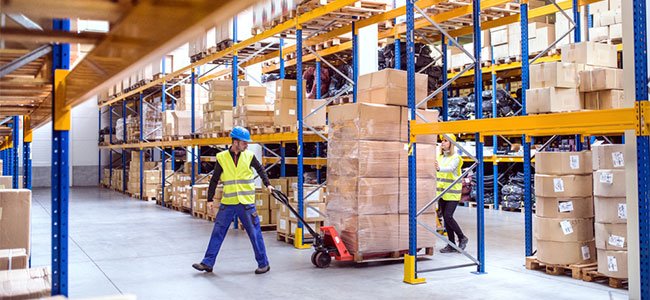Designing Safer Industrial Workspaces Through Material Flow Optimization

Industrial workspaces are constantly in motion, with materials, machines, and people all interacting at once. Keeping operations efficient and safe is a challenge many companies face. While safety gear and protocols are essential, the way materials move through the facility often has an even bigger impact on both productivity and accident prevention.
Optimizing material flow not only helps prevent bottlenecks and reduce risks but also makes daily operations smoother for everyone involved. Businesses looking to achieve this often turn to experts like John Maye Company for guidance on designing systems that keep materials moving efficiently while keeping workers safe.
In this article, we will explore how businesses can design safer industrial workspaces through material flow optimization, highlighting practical strategies.
What is Material Flow?
Material flow is simply the way raw materials, components, and finished products move through a facility, from receiving and production to storage and distribution. When material flow is efficient, items reach the right place at the right time, unnecessary handling is minimized, and delays are reduced.
When material flow is poor, it can cause congestion, slow down operations, and create safety hazards. In industrial environments, where heavy machinery, high-speed processes, and large volumes of materials are common, these risks can quickly lead to accidents. That’s why managing material flow effectively is key to both safety and productivity.
How Poor Material Flow Impacts Workplace Safety
Understanding the safety risks associated with inefficient material flow is the first step toward improvement. Common issues include:
- Cluttered Workspaces: Materials placed haphazardly can block aisles, emergency exits, and walkways. Workers navigating cluttered areas are at higher risk of trips, falls, and collisions with machinery.
- Manual Handling Risks: When materials are not strategically positioned or moved, employees often rely on manual handling. Repeated lifting, carrying, or pushing of heavy items can cause musculoskeletal injuries, strains, and fatigue.
- Increased Equipment Collisions: Poorly defined paths for forklifts, carts, or automated vehicles can lead to collisions, putting operators and other personnel at risk.
- Delays in Emergency Response: A workspace with inefficient material flow can hinder rapid evacuation or emergency interventions during fire, chemical spill, or other hazards.
These examples illustrate why optimizing material flow is not just about operational efficiency; it’s a fundamental safety measure.
Key Strategies to Optimize Material Flow for Safety
Creating a safer industrial workspace starts with understanding how materials move, where risks happen, and how small changes can make a big difference. By analyzing workflows, spotting bottlenecks, and improving processes, companies can protect employees while keeping operations efficient.
Here are some practical strategies:
1. Streamlined Layout Design
A well-organized workspace layout is the first step to safe material flow. Arrange workstations, storage areas, and equipment so materials move efficiently with minimal backtracking. For example, keep frequently used items near production lines to avoid long carrying distances.
Separate pedestrian paths from machinery routes to prevent accidents. A clear, logical layout also makes it easier for supervisors to monitor operations and keep everyone safe.
2. Implement Automation Where Possible
Automation can reduce the risks of manual handling. Conveyors, automated guided vehicles (AGVs), robotic arms, and palletizers move materials safely and reliably. Fewer employees carrying heavy items means fewer injuries and less fatigue.
Automation also ensures materials keep moving smoothly, reducing delays and keeping production lines consistent.
3. Define Clear Pathways and Signage
Even with a good layout and automation, visual guidance is important. Clearly marked aisles, equipment lanes, and warning signs guide employees and vehicle operators. For example, colour-coded paths for forklifts and pedestrians prevent collisions.
Signage is also essential in emergencies, showing the way to exits or assembly points. Keeping pathways clear and visible reinforces safety across the facility.
4. Use Modular and Flexible Storage Systems
Organized storage makes a big difference in safety and efficiency. Modular racks and shelves keep materials accessible and adaptable as production needs change. Heavy or hazardous items can be stored at safe heights, reducing the chance of injuries.
Flexible storage reduces clutter, makes it easier to find materials, and ensures employees spend less time moving items unnecessarily.
5. Regular Training and Safety Awareness
Even the best-designed flow system needs trained employees. Regular training teaches proper handling techniques, the importance of keeping pathways clear, and how to safely work with automated equipment.
Safety workshops, reminders, and hands-on exercises help employees follow best practices. When everyone knows what to do, accidents go down and operations run more smoothly.
6. Continuous Monitoring and Process Improvement
Safety and efficiency are ongoing efforts. Use tracking systems, sensors, and workflow analytics to monitor material movement, spot bottlenecks, and identify risks before they cause accidents.
Analyzing this data helps managers adjust layouts, storage, and processes. By continually improving, companies maintain safer and more efficient operations over time.
The Role of Technology in Safer Material Flow
Modern industrial operations increasingly rely on technology to enhance both safety and efficiency. Key technological interventions include:
- Real-Time Material Tracking: RFID tags, barcodes, and IoT-enabled sensors provide real-time visibility into material movement. Supervisors can quickly identify misplaced materials or blocked pathways before they cause issues.
- Data Analytics and Simulation Tools: Using historical flow data, companies can simulate alternative layouts, evaluate potential hazards, and forecast demand to optimize inventory placement and movement.
- Integration with Inventory and Production Systems: When material flow is integrated with inventory management and production planning, it ensures that materials arrive just in time, reducing clutter and minimizing the need for last-minute adjustments.
- Automation Control Systems: Smart conveyors and AGVs can dynamically adjust routes based on workflow demands, preventing congestion and collisions.
Technology complements human oversight, creating a safer, more efficient workspace that adapts to changing operational needs.
The Bottom Line
Optimizing material flow is essential for any industrial workspace that wants to be safe and productive. Things like smart layout planning, automation, clear paths, organized storage, employee training, and technology all make a big difference.
Partnering with experts like John Maye Company can make implementing these improvements easier. With their guidance and the right equipment, facilities can protect workers, improve operations, and grow more efficiently.
Ultimately, a well-optimized material flow system is an investment not just in efficiency, but in the safety and well-being of every employee in your industrial workspace.







